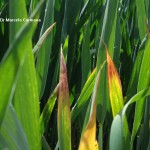.
Condición fitosanitaria: Presente
Grupo de cultivos: Cereales
Especie hospedante: Cebada (Hordeum vulgare; Hordeum vulgare var. distichon (L.) Hook.f., 1896)
Etiología: Virus
Agente causal: Barley yellow dwarf virus (BYDV)
Taxonomía: Virus > ssRNA viruses > ssRNA positive-strand viruses > no DNA stage > Luteoviridae > Luteovirus > unclassified Luteovirus > Barley yellow dwarf virus (BYDV)
Baltimore classification: Group IV: ssRNA(+) Baltimore, 1971
.
.
.
Antecedentes
Desde el año 2003 han aparecido lotes severamente infectados en la región típicamente cerealera argentina.
.
Síntomas
Las hojas se tornan amarillas y algo rojizas. Las hojas bandera se vuelven también algo rígidas y las espigas se pueden tornan oscuras.
.
.
Ciclo de la enfermedad y epidemiología
Se transmite por áfidos, principalmente pulgones. La capacidad de adquisición, latencia e infección es corta.
.
Condiciones predisponentes
Tiempo fresco y soleado. La enfermedad se manifiesta con más frecuencia e intensidad cuanto mas seco sea el tiempo de crecimiento de cultivo (preguntar a M para explicar mejor).
.
Manejo Integrado
Se recomienda utilizar cultivares resistentes, eliminar plantas guachas y gramíneas hospedantes, uso de insecticidas sistémicos en semilla. Considerar que cuanto más temprano se produzca el ataque, mayor será el daño.
.
.
Bibliografía
Delfosse VC, Barrios Barón MP, Distéfano AJ (2021) What we know about poleroviruses: Advances in understanding the functions of polerovirus proteins. Plant Pathology. doi: 10.1111/ppa.13368
(2024) How does vector diversity influence the transmission efficiency of yellow dwarf virus? Perspectives from a review. Plant Pathology 00: 1–18. doi: 10.1111/ppa.13871
Shen C, Wei C, Li J, et al. (2020) Barley yellow dwarf virus-GAV-derived vsiRNAs are involved in the production of wheat leaf yellowing symptoms by targeting chlorophyll synthase. Virol J 17: 158. doi: 10.1186/s12985-020-01434-7
Wagemans J, Holtappels D, Vainio E, et al. (2022) Going Viral: Virus-Based Biological Control Agents for Plant Protection. Annu Rev Phytopathol. 60: 21-42. doi: 10.1146/annurev-phyto-021621-114208
